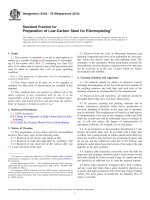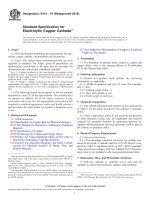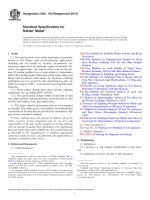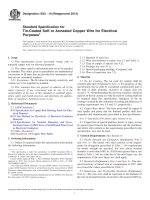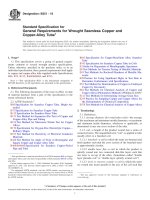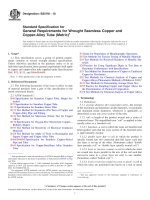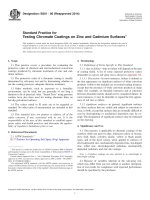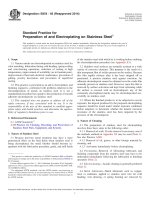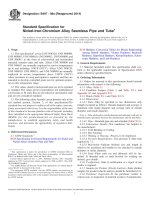Astm b 973 10 (2014)
Bạn đang xem bản rút gọn của tài liệu. Xem và tải ngay bản đầy đủ của tài liệu tại đây (98 KB, 5 trang )
Designation: B973 − 10 (Reapproved 2014)
Standard Specification for
Tin-Coated Braid and Ribbon Flat Copper Wire intended for
use in Electronic Application1
This standard is issued under the fixed designation B973; the number immediately following the designation indicates the year of
original adoption or, in the case of revision, the year of last revision. A number in parentheses indicates the year of last reapproval. A
superscript epsilon (´) indicates an editorial change since the last revision or reapproval.
1. Scope
3. Ordering Information
1.1 This specification covers tin-coated hard-drawn copper
braid and ribbon flat wire intended for electronic application
(Explanatory Note 1).
3.1 Orders for material under this specification shall include
the following information:
3.1.1 Quantity of each size,
3.1.2 Wire size-thickness and width in inches (see 5.3),
3.1.3 Type of copper, if special (see 4.2),
3.1.4 Package size (see 10.1),
3.1.5 Special packaging marking, if required, and
3.1.6 —Place of inspection (see 7.1).
1.2 The values stated in inch-pound units are to be regarded
as standard. The values given in parentheses are mathematical
conversions to SI units that are provided for information only
and are not considered standard.
1.2.1 Exceptions—The SI values for density, resistivity, and
volume are to be regarded as standard.
4. Material
1.3 This standard does not purport to address all of the
safety concerns, if any, associated with its use. It is the
responsibility of the user of this standard to establish appropriate safety and health practices and determine the applicability of regulatory limitations prior to use.
4.1 Tin for Coating—The tin shall be electroplated for the
coating and shall be commercially pure (Explanatory Note 1).
For purposes of this specification, the tin shall be considered
commercially pure if the total of other elements, exclusive of
copper, does not exceed 1 %. Not withstanding the previous
sentence, chemical analysis of the tin coating or of the tin used
for coating shall not be required under this specification.
2. Referenced Documents
2.1 ASTM Standards:2
B1 Specification for Hard-Drawn Copper Wire
B3 Specification for Soft or Annealed Copper Wire
B49 Specification for Copper Rod Drawing Stock for Electrical Purposes
B193 Test Method for Resistivity of Electrical Conductor
Materials
B258 Specification for Nominal Diameters and CrossSectional Areas of AWG Sizes of Solid Round Wires Used
as Electrical Conductors
4.2 Copper-Base Metal—The base metal shall be copper of
such quality and purity that the finished product shall have
properties and characteristics prescribed in this specification.
NOTE 1—Specifications B1, B3, or B49 defines copper suitable for use.
5. General Requirements (See Section 8)
5.1 Tensile and Elongation—The tin-coated copper flat wire
in the hard drawn condition shall conform to elongation
requirements of 1 % minimum to 5 % maximum. The tensile
strength shall be 55 000 psi (379 MPa) minimum.
2.2 Other Standards:3
NBS Handbook 100 Copper Wire Tables
5.2 Resistivity (Explanatory Note 3)—The electrical resistivity of the coated wire at a temperature of 20°C shall not
exceed the values prescribed in Table 1.
1
This specification is under the jurisdiction of ASTM Committee B01 on
Electrical Conductors and is the direct responsibility of Subcommittee B01.04 on
Conductors of Copper and Copper Alloys.
Current edition approved Oct. 1, 2014. Published October 2014. Originally
approved in 2010. Last previous edition approved in 2010 as B973 – 10. DOI:
10.1520/B0973-10R14.
2
For referenced ASTM standards, visit the ASTM website, www.astm.org, or
contact ASTM Customer Service at For Annual Book of ASTM
Standards volume information, refer to the standard’s Document Summary page on
the ASTM website.
3
Available from National Technical Information Service (NTIS), 5301 Shawnee
Rd., Alexandria, VA 22312, .
5.3 Dimensions and Permissible Variations—The flat wire
sizes shall be expressed as the thickness and width of the wire
in decimal fractions of an inch to the nearest 0.0001 in. (0.0025
mm). The tin-coated flat wire shall not vary from the specified
thickness and width by more than the amounts specified in
Table 2 and Table 3, respectively.
5.4 Continuity of Coating—The tin coating shall be continuous. The continuity of coating on the flat wire shall be
determined on representative samples taken before braiding
Copyright © ASTM International, 100 Barr Harbor Drive, PO Box C700, West Conshohocken, PA 19428-2959. United States
1
B973 − 10 (2014)
TABLE 1 Electrical Resistivity Requirements
Thickness Range,
Inch (mm)
0.0008
0.0013
0.0017
0.0025
0.0049
to
to
to
to
to
0.0012
0.0016
0.0024
0.0048
0.0100
(0.020
(0.033
(0.043
(0.064
(0.125
to
to
to
to
to
the wire was drawn from rod stock meeting the international
standard for annealed copper instead of resistivity tests on the
finished wire.
Resistivity at 20°C
Ω·lb/mile2
0.031),
0.041),
0.061),
0.122),
0.254),
incl
incl
incl
incl
incl
6.3 Dimensional Measurements—Dimensional measurements for width and thickness shall be made with a micrometer
caliper equipped with a vernier graduated in 0.0001 in. (0.0025
mm). Measurements shall be made on at least three places on
each unit selected for this test. Any measurement taken
exceeding the dimensions and permissible variation requirements in 5.4 shall constitute failure to meet the dimensional
conformance criterion.
1006.0
972.45
961.76
951.31
941.08
TABLE 2 Permissible Variations in Thickness
Nominal Thickness Range,
Inch (mm)
0.0010
0.0015
0.0020
0.0050
to
to
to
to
0.0014
0.0019
0.0049
0.0100
(0.025
(0.038
(0.051
(0.127
to
to
to
to
Tolerance,
Inch (mm)
0.036)
0.048)
0.124)
0.254)
+/+/+/+/-
0.0002
0.0003
0.0004
0.0005
6.4 Continuity of Coating:
6.4.1 Specimens:
6.4.1.1 Length of Specimens—Test specimens shall have a
length of about 6 in. (152 mm). They shall be tagged or marked
to correspond with the coil, spool, or reel from which they were
cut.
6.4.1.2 Treatment of Specimens—The specimens shall be
thoroughly cleaned by immersion in a suitable organic solvent
for at least 3 min; then removed and wiped dry with a clean,
soft cloth ( Caution-see Explanatory Note 5). The specimens
thus cleaned shall be kept wrapped in a clean, dry cloth until
tested. That part of the specimen to be immersed in the test
solution shall not be handled. Care shall be taken to avoid
abrasion by the cut ends.
6.4.2 Special Solutions Required:
6.4.2.1 Hydrochloric Acid Solution (HCl) (sp gr 1.088)—
Commercial HCl (sp gr 1.12) shall be diluted with distilled
water to a specific gravity of 1.088 measured at 15.6°C (60°F).
A portion of HCl solution having a volume of 180 mL shall be
considered to be exhausted when the number of test specimens
prescribed in Table 4 of a size as indicated in 6.4.3 have been
immersed in it for two cycles.
6.4.2.2 Sodium Polysulfide Solution (sp gr 1.142) (Explanatory Note 6)—A concentrated solution shall be made by
dissolving sodium sulfide crystals (cp) in distilled water until
(0.005)
(0.008)
(0.010)
(0.013)
TABLE 3 Permissible Variations in Width
Nominal Width Range,
Inch (mm)
0.0100 to 0.0499 (0.254 to 1.27)
0.0500 to 0.0699 (1.27 to 1.78)
0.0700 to 0.0999 (1.78 to 2.54)
0.1000 to 0.1249 (2.54 to 3.17)
0.1250 to 0.1500 (3.18 to 3.81)
Tolerance,
Inch (mm)
+/+/+/+/+/-
0.0013
0.0015
0.0020
0.0030
0.0040
(0.033)
(0.038)
(0.051)
(0.076)
(0.102)
applications or insulating. The continuity of coating shall be
determined by the hydrochloric acid-sodium polysulfide test in
accordance with 6.4.
5.5 Joints—Necessary joints in the wire and rods prior to
final coating and drawing shall be made in accordance with the
best commercial practice. There shall be no uncoated joints in
the final product.
5.6 Finish—The coating shall consist of a smooth continuous layer, firmly adherent to the surface of the copper. The wire
shall be free of all imperfections not consistent with the best
commercial practice.
TABLE 4 Limiting Number of Test Specimens for Coating TestA
6. Test Methods
6.1 Tensile Strength and Elongation (Explanatory Note 4):
6.1.1 The tensile strength, expressed in pounds per square
inch, shall be obtained by dividing the maximum load carried
by the specimen during the tension test by the original
cross-sectional area of the specimen. Tensile strength and
elongation may be determined simultaneously on the same
specimen.
6.1.2 The elongation of the flat wire may be determined by
measurements made between the jaws of the tensile testing
machine. The zero length shall be the distance between the
jaws at the start of the tension test and be as near 10 in. (254
mm) as practicable. The final length shall be the distance
between the jaws at the time of rupture. The fracture shall be
between the jaws of the testing machine and not closer than 1
in. (25.4 mm) to the jaw.
Maximum Number of
Specimens
to be Tested for 2
Cycles
in 180 mL of Acid
Solution
Equivalent Round
Nominal Diameter
6.2 Resistivity (Explanatory Note 3)—The electrical resistivity of the material shall be determined in accordance with
Test Method B193. The purchaser may accept certification that
A
2
in.
mm
Under 0.0851 to
0.0501,
incl
Under 2.2 to 1.3,
incl
6
Under 0.0501 to
0.0381,
incl
Under 1.3 to 0.97,
incl
10
Under 0.0381 to
0.0301,
incl
Under 0.97 to 0.76,
incl
12
Under 0.0301 to
0.0030,
incl
Under 0.76 to 0.076,
incl
14
See Explanatory Note 2 for equivalent round calculation.
B973 − 10 (2014)
7.1.4 The manufacturer shall, if requested prior to
inspection, certify that all wire in the lot was made under such
conditions that the product as a whole conforms to the
requirements of this specification as determined by regularly
made and recorded tests.
the solution is saturated at about 21°C (70°F), and adding
sufficient flowers of sulfur (in excess of 250 g/L of solution) to
provide complete saturation, as shown by the presence in the
solution of an excess of sulfur after the solution has been
allowed to stand for at least 24 h. The test solution shall be
made by diluting a portion of the concentrated solution with
distilled water to a specific gravity of 1.135 to 1.145 at 15.6°C
(60°F). The sodium polysulfide test solution should have
sufficient strength to blacken thoroughly a piece of clean
untinned copper wire in 5 s. The test solution used for testing
samples shall be considered exhausted if it fails to blacken a
piece of clean copper as described above.
6.4.3 Procedure:
6.4.3.1 Immersion of Specimens—Immerse a length of at
least 4.5 in. (114 mm) from each of the clean specimens, in
accordance with the following cycles, in test solutions maintained at a temperature between 15.6 and 21°C (60 and 70°F):
(1) Immerse the specimen for 1 min in the HCl solution
described in 6.4.2, wash, and wipe dry; (2) immerse the
specimen for 30 s in the sodium polysulfide solution described
in 6.4.2, wash, and wipe dry; (3) immerse the specimen for 1
min in the HCl solution, wash, and dry; (4) immerse the
specimen for 30 s in the sodium polysulfide solution, wash, and
wipe dry.
6.4.3.2 Washing Specimens—After each immersion, immediately wash the specimens thoroughly in clean water and wipe
dry with a clean, soft cloth.
6.4.3.3 Examination of Specimens—After immersion and
washing, examine the specimens to ascertain if copper exposed
through openings in the tin coating has been blackened by
action of the sodium polysulfide. The specimens shall be
considered to have failed if, by such blackening, exposed
copper is revealed. No attention shall be paid to blackening
within 0.5 in. (12.7 mm) of the cut end. A grayish brown
appearance of the coating shall not constitute failure.
7.2 Definitions Applicable to Inspection:
7.2.1 lot—any amount of wire of one type and size presented for acceptance at one time.
7.2.2 sample—a quantity of production units (coils reels,
and so forth) selected at random from the lot for the purpose of
determining conformance of the lot to the requirements of this
specification.
7.2.3 specimen—a length of wire removed for test purposes
from any individual production unit of the sample.
7.3 Sample Size (Explanatory Note 7)—The number of
production units in a sample shall be as follows:
7.3.1 A full (100 % inspection) will be completed at every
set-up prior to running the order.
7.3.2 For elongation, resistivity, dimensional measurements,
and continuity of coating determinations, the sample shall
consist of sequential production units from the lot.
7.3.3 For surface-finish inspection and for packaging inspection (when specified by the purchaser at the time of placing
the order) the sample shall consist of sequential production
units from the lot.
8. Conformance Criteria (Explanatory Note 7)
6.5 Finish—Surface-finish inspection shall be made with the
unaided eye (normal spectacles excepted).
8.1 Any lot of wire, the samples of which comply with the
conformance criteria of Section 5, shall be considered as
complying with the requirements of this standard. Individual
production units that fail to meet one or more of the requirements shall be rejected. If a failure of an individual production
unit occurs, material which was made between the nonconforming unit and the last production unit which passed the
conformance criteria must be inspected for the non-conforming
characteristic.
7. Inspection
9. Density (Explanatory Note 8)
7.1 General (Explanatory Note 7)—Unless otherwise specified in the contract or purchaser order, the manufacturer shall
be responsible for the performance of all inspection and test
requirements specified.
7.1.1 All inspections and tests shall be made at the place of
manufacture unless otherwise especially agreed upon between
the manufacturer and the purchaser at the time of purchase.
7.1.2 The manufacturer shall afford the inspector representing the purchaser all reasonable manufacturer’s facilities to
satisfy him that the material is being furnished in accordance
with this specification.
7.1.3 Unless otherwise agreed upon between the purchaser
and the manufacturer, conformance of the wire to the various
requirements listed in Section 5 shall be determined on samples
taken from each lot of wire presented for acceptance.
9.1 For the purpose of calculating linear densities, cross
sections, etc., the density of the copper shall be taken as 8.89
g/cm3(0.32117 lb/in.3) at 20°C.
10. Packaging and Shipping
10.1 Package sizes shall be agreed upon by the manufacturer and the purchaser in the placing of individual orders.
10.2 The flat wire shall be protected against damage in
ordinary handling and shipping.
11. Keywords
11.1 copper flat wire tin-coated; tin-coated annealed copper
flat wire; tin-coated copper electrical equipment flat wire;
tin-coated copper flat wire
3
B973 − 10 (2014)
TABLE 5 Resistivity Relations
Conductivity at 20°C % 100.0
93.0
92.0
91.0
90.0
87.0
875.20
941.08
951.31
961.76
972.45
1006.0
0.15328
0.16481
0.16660
0.16844
0.17031
0.17618
Ω·cmil/ft
10.371
11.152
11.273
11.397
11.523
11.921
Ω·mm2/m
0.017241
0.018539
0.018741
0.018947
0.019157
0.019818
µΩ·in.
0.67879
0.72989
0.73782
0.74593
0.75421
0.78022
µΩ·cm
1.7241
1.8539
1.8741
1.8947
1.9157
1.9818
Ω·lb/mile
Ω·g/m
2
2
EXPLANATORY NOTES
to 7 significant figures and then rounded to 5 significant figures.
NOTE 4—In general, tested values of tensile strength are increased and
tested values of elongation are reduced with increase of speed of the
moving head of the testing machine in the tension testing of copper wire.
In the case of tests on soft or annealed copper wire, however, the effects
of speed of testing are not pronounced. Tests of soft wire made at speeds
of moving head, which under no-load conditions are not greater than 12
in./min, do not alter the final results of tensile strength and elongation
determinations to any practical extent.
NOTE 5—Caution: Consideration should be given to toxicity and
flammability when selecting solvent cleaners.
NOTE 6—It is important that the polysulfide solution be of proper
composition and strength at the time of test. A solution that is not saturated
with sulfur or that has been made from decomposed sodium sulfide
crystals may give a false indication of failure. Therefore, the requirement
that the solution be tested by observing its blackening effect on a bright
copper wire is significant. Significant also is the requirement that the
solution be saturated with sulfur by allowing the solution to stand at least
24 h after preparation. Attention is called also to the necessity for the use
of sodium sulfide that has not deteriorated through exposure to air; and if
exposure has occurred, the crystals should be tested for purity. The
“Standard Reagents Tests” of the American Chemical Society are useful in
this connection.
NOTE 7—Cumulative results secured on the product of a single
manufacturer, indicating continued conformance to the criteria, are
necessary to ensure an over-all product meeting the requirements of this
specification. The sample sizes and conformance criteria given for the
various characteristics are applicable only to lots produced under these
conditions.
NOTE 8—The value of density of copper is in accordance with the
International Annealed Copper Standard. The corresponding value at 0°C
is 8.90 g/cm3 (0.32150 lb/in.3). In calculations involving density it must be
borne in mind that the apparent density of coated wire is not a constant but
a variable function of wire diameters or size. The smaller the diameter or
size, the greater the percentage of coating present, and hence, the greater
departure from the density of copper.
NOTE 1—(1) It has been found that the tin coating on copper wire
consists of two parts, an envelope of pure tin on the outside, with an
intermediate layer of copper-tin alloy. This tin alloy, as well as the amount
of tin present, has an effect on the resistivity of the wire. Since the relative
amount of tin coating and alloy is greater as the size decreases, the
resistivity of the wire increases as the size decreases.
(2) The manufacturer and user of the standard should also give
consideration to any agreed upon cast and camber requirements for ribbon
wire applications.
NOTE 2—The equivalent round diameter or size for a flat conductor is
calculated from the cross-sectional area of the flat conductor, which is
based on thickness and width. The nominal equivalent round diameter for
a flat conductor is:
Nominal Equivalent round diameter 5 = ~~ T 3 W 3 4 ! /3.1416!
where:
T = nominal thickness specification,
W = nominal width specification.
NOTE 3—Resistivity units are based on the International Annealed
Copper Standard (IACS) adopted by IEC in 1913, which is 1/58 Ω·mm2/m
at 20°C for 100 % conductivity. The value of 0.017241 Ω·mm2/m and the
value of 0.15328 Ω·g/m2 at 20°C are respectively the international
equivalent of volume and weight resistivity of annealed copper equal (to
5 significant figures) to 100 % conductivity. The latter term means that a
copper wire 1 m in length and weighing 1 g would have a resistance of
0.15328 Ω. This is equivalent to a resistivity value of 875.20 Ω·lb/mile2,
which signifies the resistance of a copper wire 1 mile in length weighing
1 lb. It is also equivalent, for example, to 1.7241 µΩ/cm of length of a
copper bar 1 cm2 in cross section. A complete discussion of this subject is
contained in NBS Handbook 100 of the National Institute of Standards and
Technology.3 The use of five significant figures in expressing resistivity
does not imply the need for greater accuracy of measurement than that
specified in Test Method B193. The use of five significant figures is
required for reasonably accurate reversible conversion from one set of
resistivity units to another. The equivalent resistivity values in Table 5
were derived from the fundamental IEC value (1/58 Ω· mm2/m) computed
4
B973 − 10 (2014)
ASTM International takes no position respecting the validity of any patent rights asserted in connection with any item mentioned
in this standard. Users of this standard are expressly advised that determination of the validity of any such patent rights, and the risk
of infringement of such rights, are entirely their own responsibility.
This standard is subject to revision at any time by the responsible technical committee and must be reviewed every five years and
if not revised, either reapproved or withdrawn. Your comments are invited either for revision of this standard or for additional standards
and should be addressed to ASTM International Headquarters. Your comments will receive careful consideration at a meeting of the
responsible technical committee, which you may attend. If you feel that your comments have not received a fair hearing you should
make your views known to the ASTM Committee on Standards, at the address shown below.
This standard is copyrighted by ASTM International, 100 Barr Harbor Drive, PO Box C700, West Conshohocken, PA 19428-2959,
United States. Individual reprints (single or multiple copies) of this standard may be obtained by contacting ASTM at the above
address or at 610-832-9585 (phone), 610-832-9555 (fax), or (e-mail); or through the ASTM website
(www.astm.org). Permission rights to photocopy the standard may also be secured from the Copyright Clearance Center, 222
Rosewood Drive, Danvers, MA 01923, Tel: (978) 646-2600; />
5
